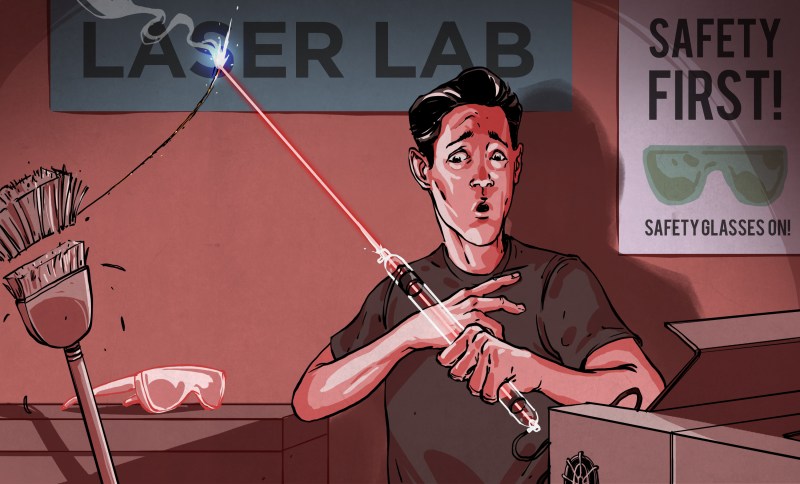Most of us strip the insulation off wires using some form of metal blade or blades. You can get many tools that do that, but you can also get by with skillfully using a pair of cutters, a razor blade or — in a pinch — a steak knife. However, modern assembly lines have another option: laser stripping. Now that many people have reasonable laser cutters, we wonder if anyone is using laser strippers either from the surplus market or of the do-it-yourself variety?
We are always surprised that thermal strippers are so uncommon since they are decidedly low-tech. Two hot blades and a spring make up the heart of them. Sure, they are usually expensive new, but you can usually pick them up used for a song. The technology for lasers doesn’t seem very difficult, although using the blue lasers most people use in cutters may not be optimal for the purpose. This commercial product, for example, uses infrared, but if you have a CO2 laser, that might be a possibility.
The technique has found use in large-scale production for a while. Of course, if you don’t care about potential mechanical damage, you can get automated stripping equipment with a big motor for a few hundred bucks.
We did find an old video about using a CO2 laser to strip ribbon cable, but nothing lately. Of course, zapping insulation creates fumes, but so does lasering everything, so we don’t think that’s what’s stopping people from this approach.
















Nice! If you add a mirror on the side you can also cut the bottom side bouncing the laser (with a particular care of where the laser goes around :) )
There is fumes and fumes. Wire insulation is most often PVC I believe so I don’t think this is a very good idea in a hobby environment without proper extraction.
My thoughts exactly
Mine too. Dangerous for humans, and terrible idea for a laser cutter.
Although it´s OK for silicon-insulated wires, those are not widespread.
With the commercial product the original poster has linked (via Laser Wire Solutions) a fume extractor is provided with each machine so it’s safe for widespread use – especially in factories – regardless of the material of the insulation.
Meh, Whats a little chlorine gas
Chlorinated hydrocarbons from the decomposition of pvc are toxic. Add oxygen and copper as a catalyst to the reaction mixture and the toxicity goes way up. There are at least several papers on the subject. There are also keywords I am not writing here.
For the same reason you don’t incinerate PVC, absolutely not a good idea.
I would be careful laser stripping because the materials most used for insulation create rather unfriendly fumes. PVC, PTFE, Kynar, etc, create fumes that need special handling, both for health (The chlorinated and fluoridated burn products, in particular) and the machine (HCl, HF)
I should guess that an industrial setup is designed to properly handle these fumes, given that stripping wire is an application where positional control of the work and airflow can be much better than a general purpose laser cutter
What are the advantages compared to a mechanical stripper that centers the wire and cuts down to a controlled diameter? My “overkill” device would have three jaws and blades, sense the wire to control the depth of the cut, and twist a little.
I would guess the same as thermal (no nicks, no ring of uncut material left making it more difficult to remove the waste, breaking, or at least loosening, the weak bond between the insulation and the wire surface), as well as being non-contact, fewer wear parts, and needing fewer moving parts in a fully automatic operation. It may be faster, as well
There aren´t, unless you plan to cut insulation on many many wires, in which case a specialized machine would be more effective and cheaper in the long run than wasting a laser cutter.
Also with the laser cutter solution, one must still do the stripping part.
I’ve wanted one ever since I saw that bomb defusing scene in “Executive Decision” back in 1996:
https://www.youtube.com/watch?v=ntT1iJNS88s
Being able to instantly strip the insulation off the center of a wire without physically disturbing it would have incredible benefits for reverse engineering and retrofitting.
Came here to say this so…ditto
Next up, ablative HE particle bombardment stripping.
Always with ventilation I just melt with a gun warm enough go around and use nature’s given wire stripper, fingernails. The next step is soldering anyway. Specifically solid wire of small gage but house wire too. That Knyar wirewrap gives to a thumbnail without tools.
I’ll get into a knife “fight” if I ever see one out of a pocket whilst wiring is being done. A small single notch pair of strippers with a sliding stop is great to have. Set it up with a stripped sample and adjust for no bite first and the rest is easy. Jeers to those big crimp-stripper things with all the separate notches inside the handle.
Mid wire stripping is easy either way with both hand’s fingernails. I’ve done a few ribbon cables with a quick pass both sides with a pointy iron, again fingernails work. Don’t let it cool, it won’t burn you.
How about trained piranhas? Just dip in the amount you want stripped, nom nom nom nom there ya go!
I’d be more interested in wire crimping with lasers XD
Hah! Thanks, Hackaday, for reminding me I actually did this 🤣
Being old-school I’ve always used my teeth, and now have an interesting, comment-gathering V-groove between the two front ones, top and bottom.
Acid…portable acid strippers. What could possibly go wrong?! ;-)
Waiting for the first HackaDay laser bris article.
The ‘First Church of Christ Computer Programmer’ should require it.
Semicolon!
https://hackaday.com/2013/11/26/laser-wire-stripping/